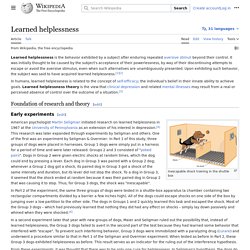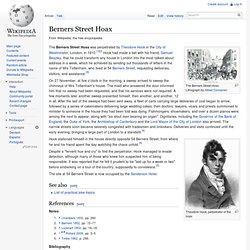

Quantum machine. Photograph of the quantum machine developed by O'Connell.

The mechanical resonator is located to the lower left of the coupling capacitor (small white square). The Seven Works of Mercy (Caravaggio) The Seven Works of Mercy (Italian: Sette opere di Misericordia), also known as The Seven Acts of Mercy, is an oil painting by Italian painter Caravaggio, circa 1607.

The painting depicts the seven corporal works of mercy in traditional Catholic belief, which are a set of compassionate acts concerning the material welfare of others. The painting was made for, and is still housed in, the church of Pio Monte della Misericordia in Naples. Originally it was meant to be seven separate panels around the church; however, Caravaggio combined all seven works of mercy in one composition which became the church's altarpiece. Learned helplessness. Psychological behavior Learned helplessness is behavior exhibited by a subject after enduring repeated aversive stimuli beyond their control.

It was initially thought to be caused from the subject's acceptance of their powerlessness: discontinuing attempts to escape or avoid the aversive stimulus, even when such alternatives are unambiguously presented. Upon exhibiting such behavior, the subject was said to have acquired learned helplessness.[1][2] Over the past few decades, neuroscience has provided insight into learned helplessness and shown that the original theory actually had it backwards: the brain's default state is to assume that control is not present, and the presence of "helpfulness" is what actually learned first. However, it is unlearned when facing with prolonged aversive stimulation.[3] In humans, learned helplessness is related to the concept of self-efficacy; the individual's belief in their innate ability to achieve goals. List of common misconceptions. From Wikipedia, the free encyclopedia This incomplete list is not intended to be exhaustive.

This list corrects erroneous beliefs that are currently widely held about notable topics. Each misconception and the corresponding facts have been discussed in published literature. Note that each entry is formatted as a correction; the misconceptions themselves are implied rather than stated. Arts and culture Food and cooking Roll-style Western sushi. Searing meat does not "seal in" moisture, and in fact may actually cause meat to lose moisture. Legislation and crime Literature. Lojong.
Lojong (Tib.

བློ་སྦྱོང་,Wylie: blo sbyong) is a mind training practice in the Tibetan Buddhist tradition based on a set of aphorisms formulated in Tibet in the 12th century by Geshe Chekhawa. The practice involves refining and purifying one's motivations and attitudes. The fifty-nine or so slogans that form the root text of the mind training practice are designed as a set of antidotes to undesired mental habits that cause suffering.
They contain both methods to expand one's viewpoint towards absolute bodhicitta, such as "Find the consciousness you had before you were born" and "Treat everything you perceive as a dream", and methods for relating to the world in a more constructive way with relative bodhicitta, such as "Be grateful to everyone" and "When everything goes wrong, treat disaster as a way to wake up. " Love styles. Love styles are modi operandi of how people love, originally developed by John Lee (1973,[1] 1988[2]).

He identified six basic love styles—also known as "colours" of love—that people use in their interpersonal relationships: Clyde Hendrick and Susan Hendrick of Texas Tech University expanded on this theory in the mid-1980s with their extensive research on what they called "love styles". They have found that men tend to be more ludic, whereas women tend to be storgic and pragmatic.
Mania is often the first love style teenagers display. Relationships based on similar love styles were found to last longer. Styles[edit] Eros[edit] List of cognitive biases. Systematic patterns of deviation from norm or rationality in judgment Cognitive biases are systematic patterns of deviation from norm and/or rationality in judgment. They are often studied in psychology, sociology and behavioral economics.[1] Although the reality of most of these biases is confirmed by reproducible research,[2][3] there are often controversies about how to classify these biases or how to explain them.[4] Several theoretical causes are known for some cognitive biases, which provides a classification of biases by their common generative mechanism (such as noisy information-processing[5]).
Gerd Gigerenzer has criticized the framing of cognitive biases as errors in judgment, and favors interpreting them as arising from rational deviations from logical thought.[6] Explanations include information-processing rules (i.e., mental shortcuts), called heuristics, that the brain uses to produce decisions or judgments. Belief, decision-making and behavioral[edit] Social[edit] [edit] Places in Harry Potter. J.

K. Rowling's Harry Potter universe contains numerous settings for the events in her fantasy novels. These locations are categorised as a dwelling, school, shopping district, or government-affiliated locale. Dwellings[edit] The Burrow[edit] List of murderers by number of victims. List of common misconceptions. Paralanguage. Paralinguistic information, because it is phenomenal, belongs to the external speech signal (Ferdinand de Saussure's parole) but not to the arbitrary conventional code of language (Saussure's langue).

The paralinguistic properties of speech play an important role in human communication. There are no utterances or speech signals that lack paralinguistic properties, since speech requires the presence of a voice that can be modulated. This voice must have some properties, and all the properties of a voice as such are paralinguistic. However, the distinction linguistic vs. paralinguistic applies not only to speech but to writing and sign language as well, and it is not bound to any sensory modality. Even vocal language has some paralinguistic as well as linguistic properties that can be seen (lip reading, McGurk effect), and even felt, e.g. by the Tadoma method. Parataxic distortion. Parataxic distortion is a psychiatric term first used by Harry S.

Sullivan to describe the inclination to skew perceptions of others based on fantasy. The "distortion" is a faulty perception of others, based not on actual experience with the other individual, but on a projected fantasy personality attributed to the individual. Berners Street Hoax. The Berners Street Hoax was perpetrated by Theodore Hook in the City of Westminster, London, in 1810.

Hook had made a bet with his friend, Samuel Beazley, that he could transform any house in London into the most talked-about address in a week, which he achieved by sending out thousands of letters in the name of Mrs Tottenham, who lived at 54 Berners Street, requesting deliveries, visitors, and assistance. On 27 November, at five o’clock in the morning, a sweep arrived to sweep the chimneys of Mrs Tottenham's house. The Thirty-Six Dramatic Situations. The Thirty-Six Dramatic Situations is a descriptive list which was created by Georges Polti to categorize every dramatic situation that might occur in a story or performance.
To do this Polti analyzed classical Greek texts, plus classical and contemporaneous French works. He also analyzed a handful of non-French authors. In his introduction, Polti claims to be continuing the work of Carlo Gozzi, who also identified 36 situations. Publication history[edit]